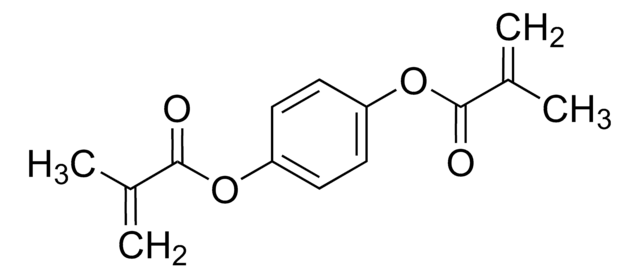494356
Bisphenol A-Glycerolatdimethacrylat
glycerol/phenol 1
Synonym(e):
2,2′-Bis[4-(3-methacryloxy-2-hydroxypropoxy)phenyl]propan, 2,2′-Bis[4-(3-methacryloyloxy-2-hydroxypropoxy)phenyl]propan, 2,2-Bis[p -(3-methacryloxy-2-hydroxypropoxy)phenyl]propan, 2,2-Bis[p -[2-hydroxy-3-(methacryloxy)propoxy]phenyl]propan, Bisphenol-A-bis(2-hydroxy-3-methacryloxypropyl)ether
About This Item
Empfohlene Produkte
Zusammensetzung
glycerol/phenol, 1
Brechungsindex
n20/D 1.552 (lit.)
Dichte
1.161 g/mL at 25 °C (lit.)
Lagertemp.
2-8°C
SMILES String
CC(=C)C(=O)OCC(O)COc1ccc(cc1)C(C)(C)c2ccc(OCC(O)COC(=O)C(C)=C)cc2
InChI
1S/C29H36O8/c1-19(2)27(32)36-17-23(30)15-34-25-11-7-21(8-12-25)29(5,6)22-9-13-26(14-10-22)35-16-24(31)18-37-28(33)20(3)4/h7-14,23-24,30-31H,1,3,15-18H2,2,4-6H3
InChIKey
AMFGWXWBFGVCKG-UHFFFAOYSA-N
Verwandte Kategorien
Allgemeine Beschreibung
- der Phenylring bietet Chemikalienbeständigkeit
- die Etherbindung bietet Flexibilität
- die Hydroxygruppe bietet eine gute Anhaftung
- das Methacrylat ist die reaktive Stelle für die Vernetzung
Anwendung
- Als Vernetzungsmonomer bei der Herstellung von zwitterionischen monolithischen Säulen für die Flüssigchromatografie.
- Bei der Herstellung eines antibakteriellen Dentalklebers.
Signalwort
Danger
H-Sätze
Gefahreneinstufungen
Aquatic Chronic 3 - Eye Dam. 1 - Skin Sens. 1
Lagerklassenschlüssel
10 - Combustible liquids
WGK
WGK 2
Flammpunkt (°F)
230.0 °F
Flammpunkt (°C)
110 °C
Analysenzertifikate (COA)
Suchen Sie nach Analysenzertifikate (COA), indem Sie die Lot-/Chargennummer des Produkts eingeben. Lot- und Chargennummern sind auf dem Produktetikett hinter den Wörtern ‘Lot’ oder ‘Batch’ (Lot oder Charge) zu finden.
Besitzen Sie dieses Produkt bereits?
In der Dokumentenbibliothek finden Sie die Dokumentation zu den Produkten, die Sie kürzlich erworben haben.
Kunden haben sich ebenfalls angesehen
Artikel
With dentists placing nearly 100 million dental fillings into patients′ teeth annually in the U.S. alone, polymeric composite restoratives account for a very large share of the biomaterials market.
Unser Team von Wissenschaftlern verfügt über Erfahrung in allen Forschungsbereichen einschließlich Life Science, Materialwissenschaften, chemischer Synthese, Chromatographie, Analytik und vielen mehr..
Setzen Sie sich mit dem technischen Dienst in Verbindung.















